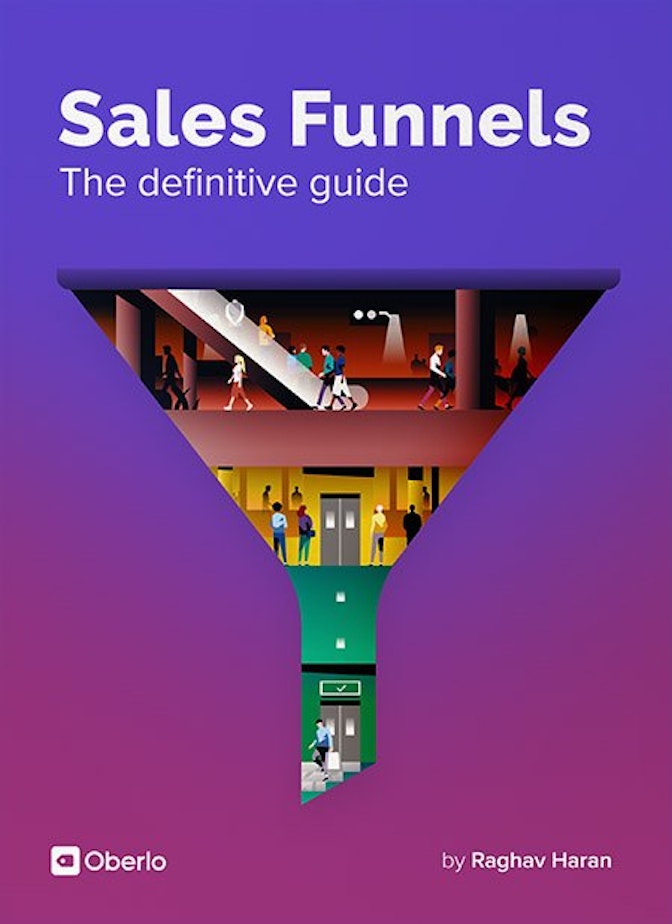When you’re first starting your online business, it’s all about short-term hacks like cold calling, cold emailing, and affiliate marketing. While these short-term tactics can get you those first few sales, your long-term success will depend on you creating an effective marketing funnel.
According to studies, 73% of leads are not ready to be sold to. That means that no matter where they come from, no matter how you source them, the vast majority of leads will not be ready to buy from right away.
That’s where lead nurturing comes into play.
Lead nurturing is the process of guiding leads along the path to buying from you. And if you’re relying on random tactics to grow your business, you’d be leaving hundreds, thousands, or even tens of thousands of dollars on the table.
Without a structured marketing funnel to take people from first learning about you to buying from you, there’s no way to have a long-term system to grow your business.
When a business has a structured marketing funnel, conversion rates will increase greatly and, hopefully, boost your profits.
In this chapter, we’ll give you a quick recap of the buyer’s journey. Then, we’ll talk about how to build a powerful marketing funnel that gets (and keeps) customers for the long term.
A marketing funnel is the process your customers take from beginning to end – from first hearing about your product to the time they actually pull the trigger and make the purchase.
Before you can understand the stages of a marketing funnel, we need to first recap the anatomy of the buyer’s journey, which we covered in Chapter 1.
Here are the stages of the buyer’s journey.
Stage 1: Awareness
At the awareness stage, customers would have just discovered your brand. This could happen on challenges like your website, social media, advertising or something else. At this stage, customers don’t know much about your company or who you are.
Stage 2: Consideration
At the consideration stage, customers would be learning more about your product or service to see what you have to offer. They’d be doing things like looking at product reviews, adding items to their cart, etc.
Stage 3: Preference
Not all marketing funnels take this step into account – many just skip straight from ‘consideration’ to ‘purchase’.
While this might seem like an unnecessary detail, customers do research on your company’s products (and similar products) at the preference stage. You could also think of this stage as part of the ‘consideration’ stage.
At this stage, product reviews matter the most.
Because customers are evaluating your products at this stage, it’s the most important part of the customer journey. Customers typically don’t read that many reviews before forming a lasting opinion about your product – and according to the numbers, 84% of shoppers trust online reviews just as much as personal recommendations.
At the preference/consideration stage, it’s important to have things like case studies, testimonials, and product reviews.
Stage 4: Purchase
The final stage is the purchase stage, where customers are ready to finally make a transaction.
After this stage comes the most important part for businesses: retention.
We’ll go more in depth on the purchase stage of the marketing funnel and what comes afterwards in the coming chapters.



2.1 How to Map Your Marketing Funnel
A marketing funnel helps guide people from the awareness stage to the purchase and the upsell stage by nurturing them with the right content.
There are three main stages of the marketing funnel: 1) Top of Funnel, 2) Middle of Funnel, and 3) Bottom of Funnel.
→ Click Here to Launch Your Online Business with Shopify
Here’s a marketing funnel graphic:
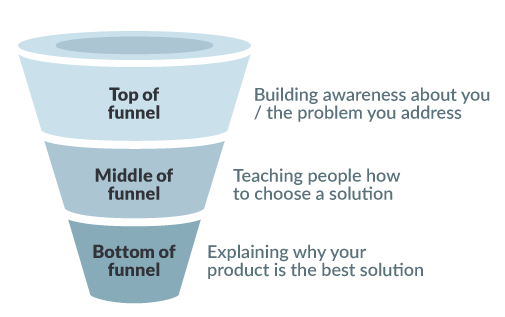
To build a profitable funnel, you need to create the right type of content for each stage of the marketing funnel. However, 65% of marketers are still challenged when it comes to understanding which types of content are effective and the types of content aren’t.
The ‘top of funnel’ (ToFu) helps build awareness around your product, or the problem you’re looking to solve.
If you’re running an online business, your top-of-funnel might consist of advertising on Instagram or Facebook. If you’re running an online business selling digital products, it might be blog posts that give free information around the problem you’re solving.
At the top of funnel, customers are just finding out about your business. While some hot leads might be ready to buy right away, the vast majority won’t be ready yet. At this stage, most customers are just beginning to gather information they need to understand more about their needs.
The next marketing funnel stage is the ‘middle-of-funnel’, or MoFu.
At this stage, customers are beginning to evaluate products at a deeper level. They start learning more about the problem they’re looking to solve, or the products they’re looking to get.
At the middle-of-funnel stage, customers would be looking for information that helps them answer their questions about choosing a solution. Good MoFu content might be things like advertorials, video tutorials, podcasts, or webinars.
The final stage is called the ‘bottom of funnel’, or BoFu.
We’ll touch more on BoFu in the coming chapters. Basically, BoFu content is about showing customers why your solution is the right one for them. They’ve gotten information about their problem, they’ve learned how to choose a solution, and they’re now evaluating products against each other to see which one is the best fit.
At this stage, things like free consultations, webinars, or discount codes could get customers across the finish line.
To see these steps in more practical detail, we’ll refer to what Neil Patel calls the ‘conversion funnel’ in the coming sections. This process will improve your marketing funnel conversion rates.
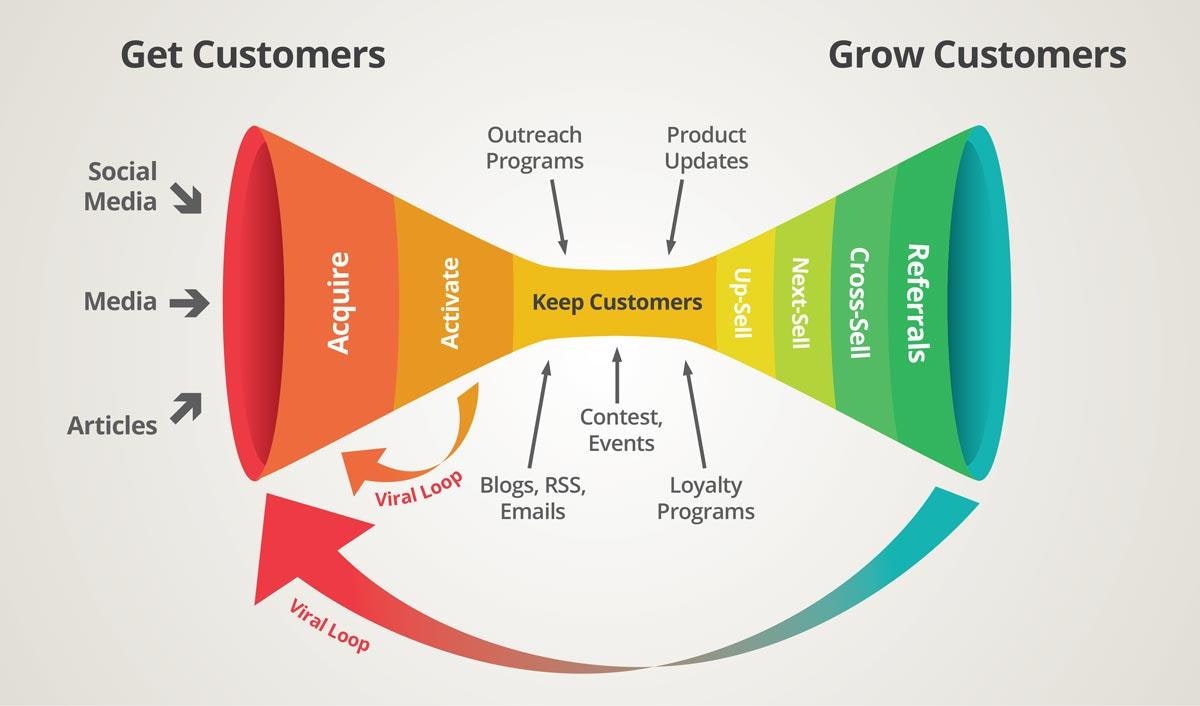
Source: 2Stations
The conversion funnel follows the same ToFu → MoFu → BoFu stages. In the next section, we’ll talk more about how to create content for each of those stages.
2.2 How to Craft Top-of-Funnel (ToFu) Content
ToFu content is usually built with the intention of helping customers become aware of the problem that your product solves.
If a person doesn’t know they have a problem, there’s no way they’re going to make the purchase. If they’re not aware of their problem, they have no context – and they’re not going to understand why they even need your product in the first place.
If you’re selling sales software, your customers’ problems might involve scaling their sales team. If you’re selling shoes, your customers’ might be looking for ways to improve their style. These problems can range from something that’s easily-solved with tactics and templates to problems that are more intangible.
Let’s say your car has a flat tire. Your problem is a tangible, real challenge that has a relatively quick solution: you need a new tire. And if you don’t know how to replace it yourself, you’d need someone to help you. But if you’re looking for a new computer for example, you might need more help in solving your problem. Should you look for a MacBook or a PC? If you go for a MacBook, what kind of MacBook should you get?
The more advanced the problem is, the more difficult it would be to find a solution. For example, you might be looking for a lawyer for legal help in an area you’re totally unfamiliar with.
For different types of businesses, the needs of customers at the ‘top of funnel’ stage would be different.
If you’re running a web development agency, your clients would first realize that they have a problem around your area of expertise (i.e. a slow website, or bad design).
Understanding will help you craft the right type of content to bring awareness to your business or product.
Top of funnel content is usually geared towards attracting a broad audience – an audience that might be searching for high-level topics associated with your brand.
At this stage, high-level educational content is best.
For example, check out this article by MindBodyGreen, a site in the wellness niche that sells courses on things like mindfulness and nutrition:
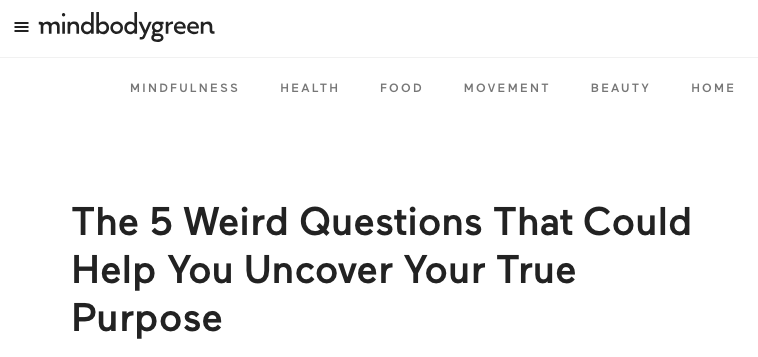
They wrote a ToFu blog post titled ‘5 Weird Questions That Could Help You Uncover Your True Purpose’ to attract people who might want to explore more about finding themselves, spirituality, and so on.
You can use Google’s search suggestions to uncover questions your target audience might have in the awareness stage. These are the questions you could help answer with your top of funnel content.
For example, let’s say you’re selling a fitness product to help people gain muscle. At the top of the funnel, your audience will be searching for content to learn more about strength training or weight training. To uncover specific questions, you can type in something like the following into Google search, and see what search suggestions come up below:
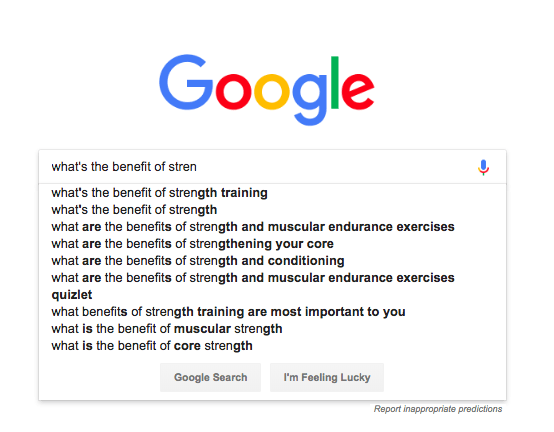
In the case of strength training, you could write a blog post on the benefits of strength training, why you should strength train, benefits of strengthening different parts of your body (i.e. your core, etc) to bring people into your world by giving them the information they need.
You could also use a tool like AnswerThePublic.com, and get dozens of key phrases related to a topic (i.e. strength training) that you can use to craft content.
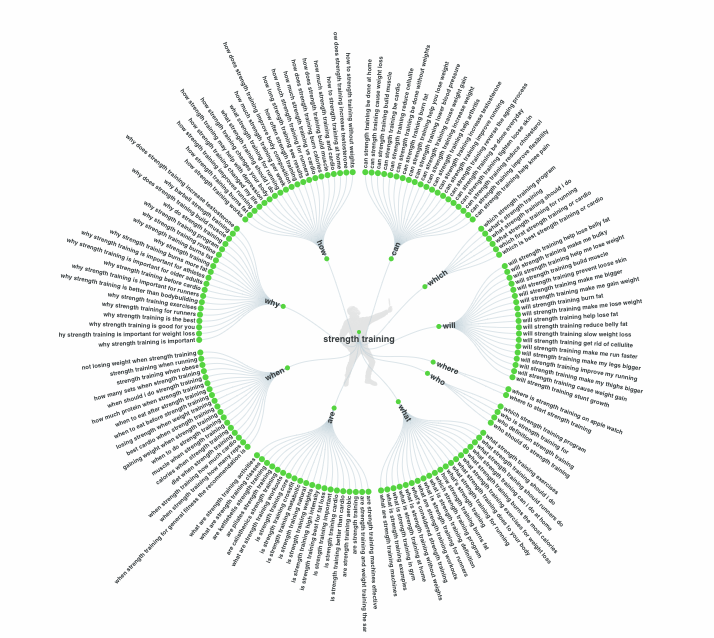
Your top-of-funnel content could take the form of articles, interactive quizzes, or even videos.
For example, here are a couple of videos fitness entrepreneurs have posted on YouTube as part of their top-of-funnel content:
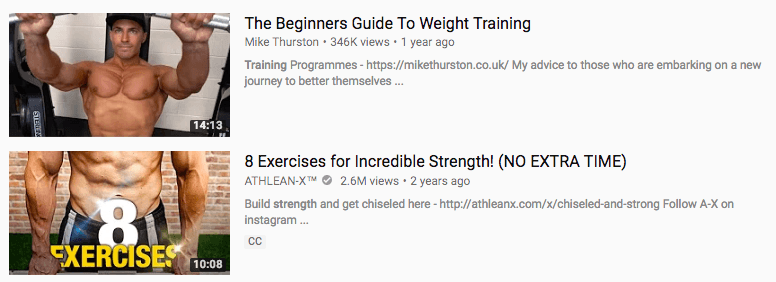
While the main purpose of top-of-funnel content is to educate customers about their problems, another goal is to get their contact information so that you can contact them again.
This might involve them subscribing to your YouTube channel, or sign up to your email list.
One way MindBodyGreen gets people on their email list is by offering a free webinar link at the bottom of some of their blog posts. Readers can click through, enter their name and email, and register for the event.
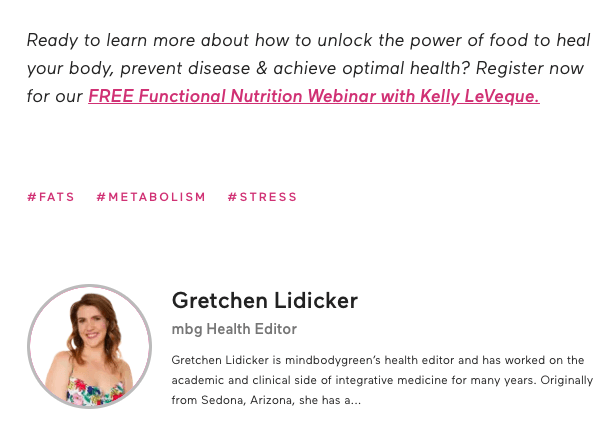
This way, the company can continue to send subscribers content as they move down the funnel.
2.3 How to Craft Middle-of-Funnel (MoFu) Content
At the middle of the funnel, customers will be at a point where they’ll be evaluating different products and offerings.
At this point, you may have already gotten their email address or contact information as well.
In the middle of the funnel (or ‘consideration’ stage), buyers would be looking for content that shows how you can directly help them. It’s the time when customers evaluate the best way to actually solve their problem, and what products they would need to do that.
MoFu content is the most important type of content in the marketing funnel. According to Digital Marketer, a thoughtful MoFu campaign could get two or three times the return of ToFu content for online businesses.
To create MoFu content, you can use the same tactics that you’d use for ToFu content. But at the middle-of-funnel stage, you’d have to create content around the specific benefits, qualities, and address drawbacks of your product.
For example, let’s say you’re selling protein supplements for fitness products.
In this case, you could use Google’s search suggestions to uncover keywords that people search for for as they evaluate protein supplements.
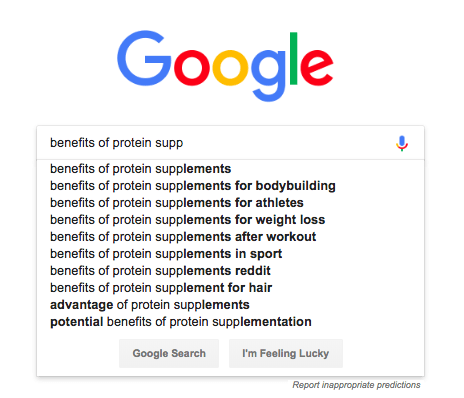
The process is similar to the keyword research you’d do for ToFu content – but for MoFu content, the articles would be more focused around your product (i.e. protein supplements) than the value that you’re bringing (i.e. strength training).
The content you’d create at this stage could be how-to blog posts, video tutorials, case studies, success stories, or demo videos.
For example, Tactics, a skate shop, posts videos of shoe reviews. They source product reviews from customers, and post those reviews on YouTube for other potential customers to evaluate the products.
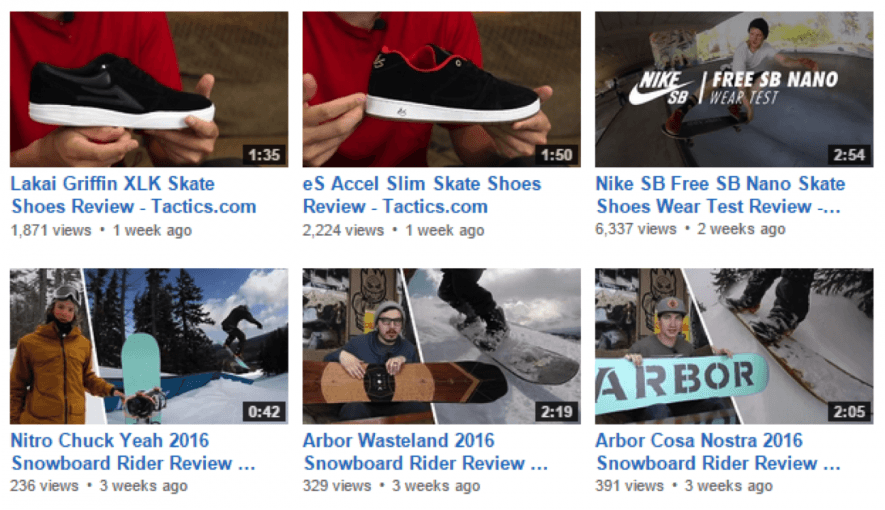
Same concept could be used for other industries as well. If you search ‘protein supplement reviews’, you’ll get a list of videos of product reviews from businesses:
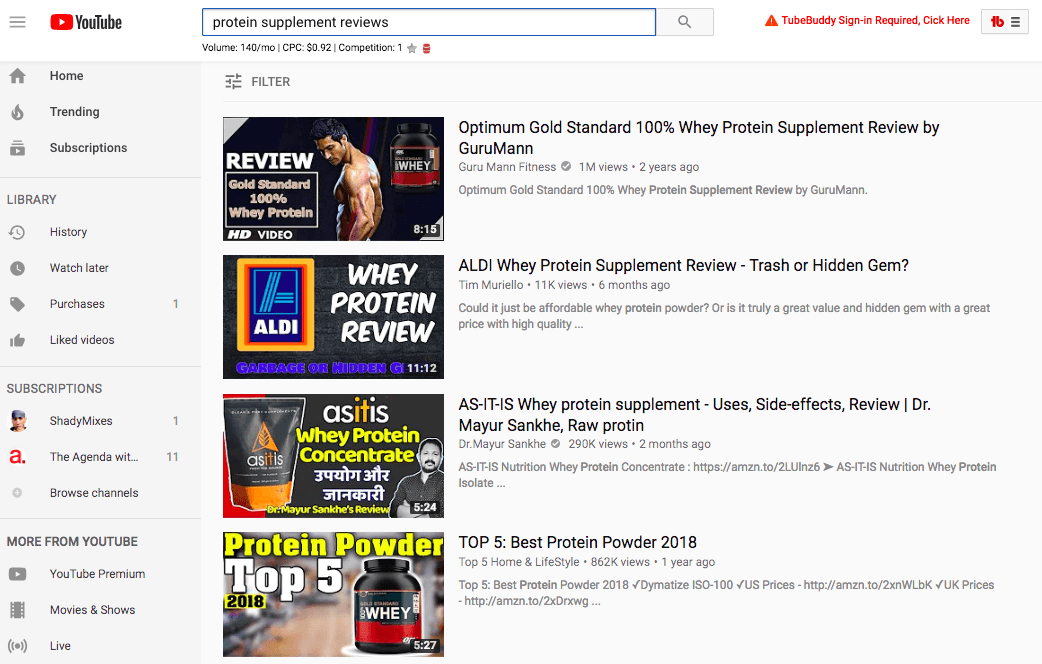
While many businesses share their middle-of-funnel content on the web in the form of videos and blog posts, you can also share that content with subscribers through an email autoresponder sequence.
Your autoresponder sequence can also be used to generate content ideas for your funnel. For example, check out the first email Wesley Parker sends in his autoresponder sequence:
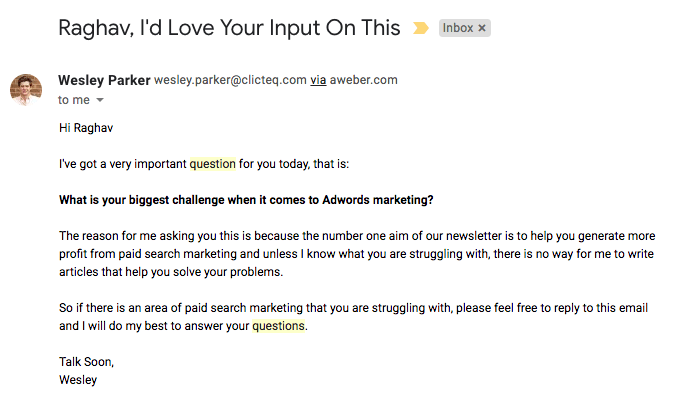
In the email, he writes:
“I’ve got a very important question for you today, that is:
What is your biggest challenge when it comes to Adwords marketing?
The reason for me asking you this is because the number one aim of our newsletter is to help you generate more profit from paid search marketing and unless I know what you are struggling with, there is no way for me to write articles that help you solve your problems.
So if there is an area of paid search marketing that you are struggling with, please feel free to reply to this email and I will do my best to answer those questions.”
The main focus of the email was asking, “What’s your biggest challenge when it comes to Adwords marketing?”
You can create a similar first email around whatever problem you’re trying to solve – whether it’s related to fitness, fashion, marketing, or anything else. Based on the responses, you can create MoFu content specifically for your audience’s needs.
Ultimately, the goal of this type of content is to help customers move towards the process of making a decision in the final stage of the sales funnel.
We’ll cover the bottom-of-funnel stage in the coming chapters, along with upsells and customer retention.
2.4 A Step-by-Step Marketing Funnel Template
As you can tell, the marketing funnel stages follow the buyer’s journey pretty closely.
The top-of-funnel stage is the stage when customers become ‘aware’ of their problem and/or your business. At the middle of the funnel, they’re at the ‘consideration’ stage. At the bottom of the funnel, they get to the point where they’re ready to make a purchase.
The following marketing funnel template breaks down each of the stages, goals, and some additional tips on email marketing strategies you can use at each step:
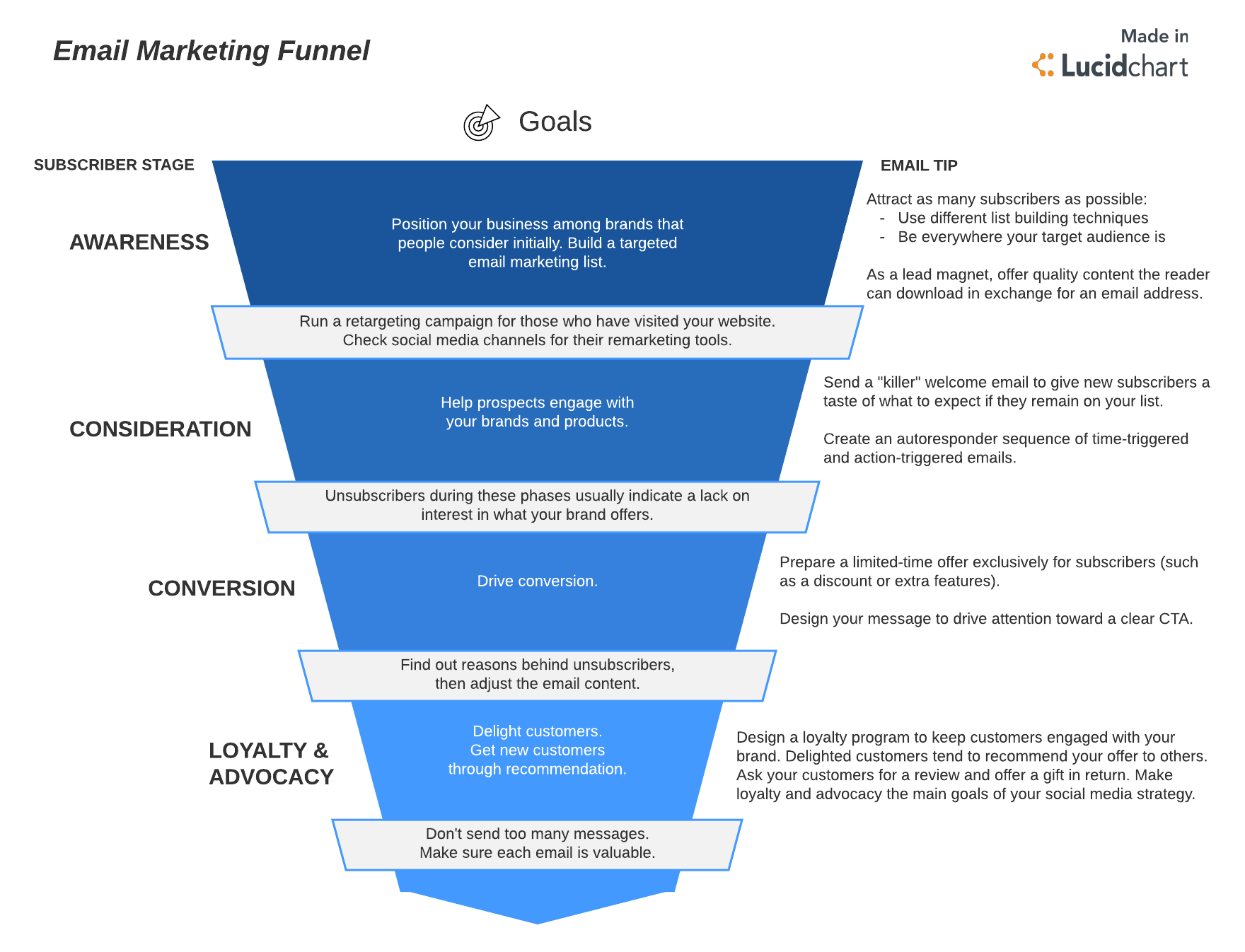
At the top of the funnel, the goal is to create high-level, broad pieces of content that attract visitors – and if you can, generate email subscribers so you can push them down the funnel even faster.
From there, you can push subscribers into an email autoresponder sequence through the consideration stage and beyond.
In the coming chapters, we’ll discuss the later stages of the marketing funnel in more detail.



Chapter 2 Takeaways
- The marketing funnel stages are: 1) Top of Funnel, 2) Middle of Funnel, and 3) Bottom of Funnel. Your content should be optimized for each of the marketing funnel stages.
- Top-of-funnel content should create awareness about the problem your product or service sells. Middle-of-funnel content should help your potential customers evaluate the various products or services available to them. Bottom-of-funnel content should convince customers that your product or service is right for them.
- Use a marketing funnel template to plan and optimize your content.
Simply put, a well-crafted marketing funnel is essential to ensuring your business’s long-term success.

